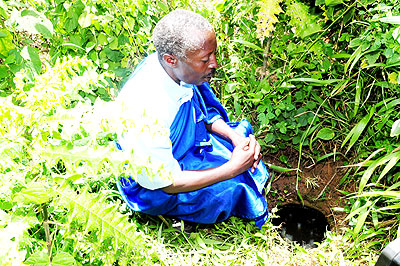Mention meteorology and its modern technological tools and one would think that before these fancy wonder gadgets arrived into the land of a thousand hills, weather was a thing people only saw happen.


Mention meteorology and its modern technological tools and one would think that before these fancy wonder gadgets arrived into the land of a thousand hills, weather was a thing people only saw happen.But you will be shocked to learn that Rwandans were predicting weather patterns years before met came to the land, thanks to Ivubiro, a traditional method of "seeing rain and the sun.”This came to the fore on Monday as Rwanda joined the rest of the world to celebrate International Mother Language Day in Muhondo sector, Gakenke district, in Northern Province.Located in Gahinga village, Huro cell, the famous Ivubiro was thought to have been initiated by King Ruganzu II Ndoli.Legend has it that having stayed in Tanzania before, Ruganzu II arrived in Rwanda when there was severe drought. He immediately went to place called Busigi to find rainmakers, locally called Abavubyi.The rainmakers at the time operated three sites (Amavubiro), including those which are no longer operational. In the Ivubiro there is a pot-like dish inserted into the ground on a top of Huro highland. The hilltop was preserved.Gaëta Niyitegeka, 61, said Ivubiro was efficiently used traditionally to know an appropriate season for farming. It was also used to predict abundance or scarcity of rain in the following seasons.Healing and magical power Not only the site was conceived to indicate meteorological related issues but also the water from the said pot is depicted with healing power.Asked what she knows about Ivubiro, Clarisse Iradukunda, 20, said that she has heard people saying that water drawn from the pot heals wounds.Anastasie Mukazitoni echoes the same, adding that there is a magical power associated with the named site."If any person does anything wrong about this Ivubiro, they face severe consequences and previously there are some people who fell victims,” she said.The natural meteorological sites existed in place in three regions in Gakenke district. However, one at Huro is still intact.Residents and local authorities have called for help to maintain and transform Ivubiro into tourist site to generate income.Deogratias Nzamwita, the mayor of Gakenke district, said they are looking at ways of preserving and sustaining the cultural site.The other sites were set in Gahira, Coko sector, another one in Kabona in Rushashi sector and one of Huro in Muhondo sector, which is still operational.
------------------------------------------------------
How it worksNiyitegeka and other elderly people in the area said with the Ivubiro, weather is predicted through the observation of humidity, and decrease or increase of the waters in the pot. When the quantity of water went high, we are already informed that rain season is over and we get ready for farming activities and when the quantity is decreased we know that there is no rain. Niyiteka shows the Ivubiro ‘pot’ on the hill. The New Times/ Noël Turikumwe


